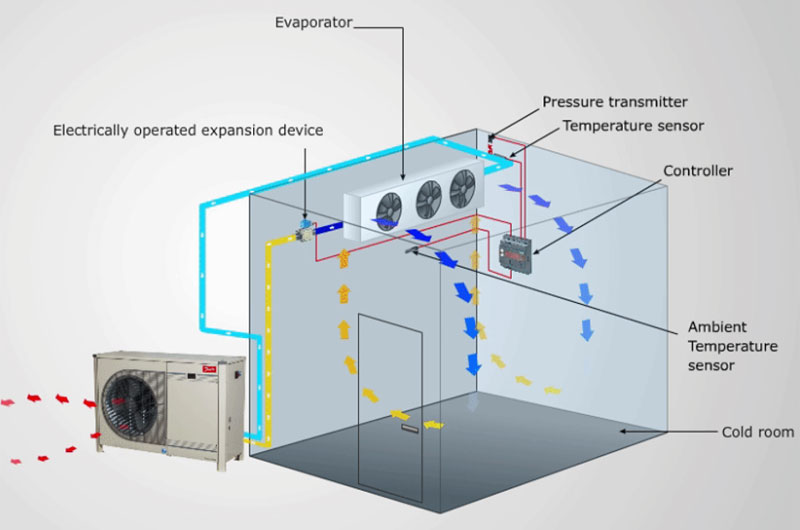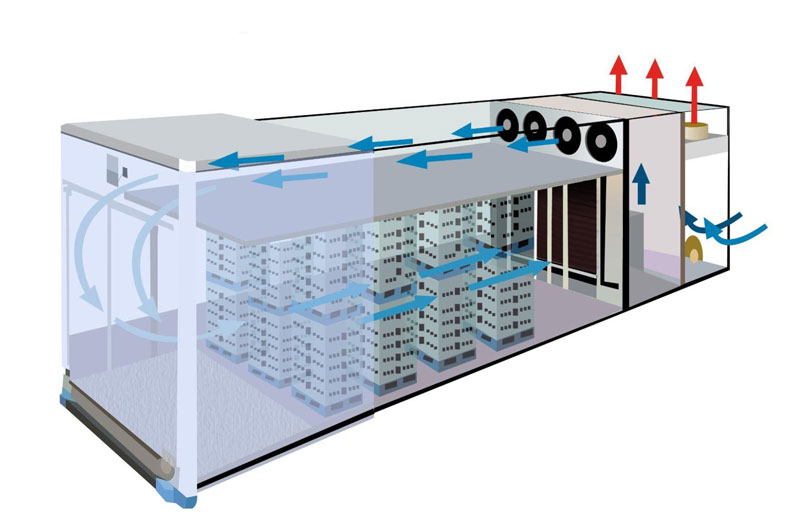In cold storage facilities, properly designed airflow systems ensure uniform temperature distribution, prevent hotspots, minimize energy consumption, and reduce spoilage risks.
Understanding Airflow in a Cold Room
Airflow dynamics refer to the movement, direction, velocity, and distribution of air within a cold storage space. Cold rooms typically use evaporator fans or air coolers to blow cold air throughout the chamber.
The behavior of this air, how it moves, interacts with stored goods, and returns to the evaporator, determines how well the room maintains a uniform low temperature.
There are three key aspects to consider:
- Air velocity and volume
- Air distribution and circulation patterns
- Return air pathways and stratification control
Why Airflow Matters in Cold Storage?

Poor airflow design or blocked air circulation can lead to:
- Temperature stratification (cold and warm zones)
- Moisture accumulation and condensation
- Uneven product temperatures
- Higher energy consumption
- Accelerated product deterioration
In contrast, well-optimized airflow ensures:
- Even cooling throughout the room
- Minimized heat infiltration
- Better product preservation
- Reduced compressor workload
Key Components Influencing Airflow
1. Evaporator Fans
These fans are the heart of airflow dynamics in a cold room. They draw in warm return air and circulate chilled air into the room. Factors such as fan size, blade angle, speed, and placement greatly affect the room’s cooling efficiency.
2. Racking Systems
The arrangement of storage racks influences how air travels through the space. For optimal airflow, racks should allow sufficient space between units and avoid blocking return air paths.
3. Air Distribution Patterns
There are two primary methods:
- Direct airflow (throw): Cold air is directed from evaporators across the room in a straight path.
- Circulatory flow: Designed to create a looping air movement that minimizes stagnation and balances temperature.
4. Return Air Pathways
A proper return path is essential to recirculate the air effectively. If the return pathway is blocked (by overstacked pallets or improper layout), cooling efficiency drops significantly.
Best Practices for Cold Room Airflow Optimization
1. Design with CFD Analysis
Computational Fluid Dynamics (CFD) modeling is a simulation technique used during cold room design to predict airflow patterns. It helps identify potential airflow dead zones, optimize fan placements, and balance air distribution.
2. Maintain Proper Clearance
Always leave adequate clearance between:
- Walls and stored goods (at least 10–15 cm)
- Ceiling and top of the racks
- Floor and bottom of the pallets
This enables better airflow circulation and prevents cold air stagnation.
3. Optimize Air Throw Direction
Evaporator fans should direct airflow across the length of the room, not at the entrance or walls. Ideally, air should flow across the products, be deflected down, and then return along the floor to the evaporator.
4. Use Air Ducting (If Needed)
For larger or unusually shaped rooms, air ducting helps channel airflow uniformly to all areas. It is especially useful when airflow doesn’t reach certain zones due to distance or obstruction.
5. Avoid Overloading the Cold Room
Overloading disrupts airflow and creates hotspots. Always follow the recommended storage layout. Proper load spacing prevents cold air blockage and promotes consistent temperatures.
Common Airflow Problems and How to Solve Them
| Problem | Cause | Solution |
| Hot spots near doors | Frequent door opening or inadequate air curtains | Use strip curtains or airlocks, and limit open-door times |
| Ice build-up on evaporators | Poor airflow return or high humidity | Defrost evaporators regularly and maintain return air paths |
| Uneven temperatures | Poor fan placement or obstructed airflow | Re-evaluate fan setup and storage layout |
| Excess energy use | Fans running continuously at full speed | Use variable speed fans and temperature sensors |
Special Considerations by Cold Room Type
1. Walk-in Coolers for Perishables
Require moderate airflow (low velocity) to prevent product dehydration. Avoid direct airflow onto produce.
2. Freezers
Need stronger, continuous airflow to maintain -18°C or lower. Air stratification is more likely here, so return airflow management is critical.
3. Pharmaceutical Cold Rooms
Strict temperature uniformity (±1°C) is mandatory. CFD simulations, high-efficiency fans, and air balancing are often required to meet regulatory standards.
Technological Advancements in Airflow Control
1. Variable-Speed Fans
Adjust fan speed according to temperature demand, reducing energy costs and preventing overcooling.
2. Smart Sensors and Monitoring
Modern systems use IoT sensors to continuously monitor airflow, temperature, and humidity, enabling proactive maintenance and faster issue detection.
3. Adaptive Control Systems
Some cold rooms use AI-based controllers that learn usage patterns and optimize airflow distribution automatically.
The Role of Maintenance in Sustaining Airflow Efficiency
Even the best airflow design can fail without regular maintenance:
- Clean evaporator coils and fans regularly to prevent dust or frost buildup.
- Inspect fan motors and belts for wear and tear.
- Check airflow velocity at different points periodically to detect imbalances.
- Ensure sensors are calibrated and working correctly.

